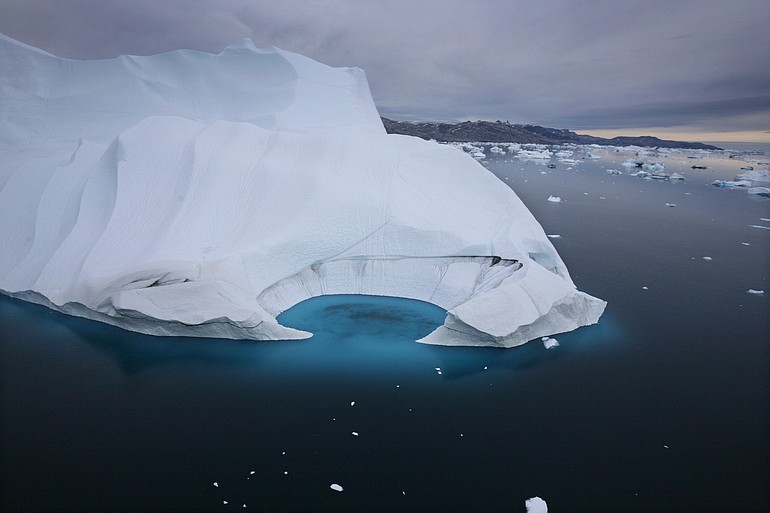STOCKHOLM (AP) — The ice of Greenland and the rest of the Arctic is melting faster than expected and could help raise global sea levels by as much as 5 feet this century, dramatically higher than earlier projections, an authoritative international assessment says.
The findings “emphasize the need for greater urgency” in combating global warming, says the report of the Arctic Monitoring and Assessment Program (AMAP), the scientific arm of the eight-nation Arctic Council.
The warning of much higher seas comes as the world’s nations remain bogged down in their two-decade-long talks on reducing emissions of carbon dioxide and other greenhouse gases blamed for global warming.
Rising sea levels are expected to cause some of global warming’s worst damage — from inundated small islands to possible flooding of New York City’s subways. Oceans will not rise uniformly worldwide, because of currents, winds and other factors, but such low-lying areas as Bangladesh and Florida will likely be hard-hit.
The new report, whose executive summary was obtained by The Associated Press, is to be delivered to U.S. Secretary of State Hillary Rodham Clinton and foreign ministers of the other seven member nations at an Arctic Council meeting next week in Greenland. It first will be discussed by some 400 international scientists at a conference this week in Copenhagen, Denmark.
Drawing on improved research techniques and recent scientific papers, the AMAP report updates forecasts made by the U.N.’s expert panel on climate change in its last major assessment in 2007.
The melting of Arctic glaciers and ice caps, including Greenland’s massive ice sheet, is projected to help raise global sea levels by 35 to 63 inches (90 to 160 centimeters) by 2100, AMAP said, although it noted that estimate was highly uncertain.
That’s up from the 2007 projection of 7 to 23 inches (19 to 59 centimeters) by the U.N. panel. The U.N. group had left out the possible acceleration of melting in Greenland and Antarctica, saying research on that hadn’t advanced sufficiently by the mid-2000s. The U.N. estimate was based largely on the expansion of ocean waters from warming and the runoff from melting land glaciers elsewhere in the world.
Now the AMAP assessment finds that Greenland was losing ice in the 2004-2009 period four times faster than in 1995-2000.
In addition, the cover of sea ice on the Arctic Ocean is shrinking faster than projected by the U.N. panel, threatening the long-term survival of polar bears and other ice-dependent species. Summer ice coverage has been at or near record lows every year since 2001, said AMAP, predicting the ocean will be almost ice-free in the summer in 30 to 40 years.
Arctic temperatures in the past six years were the highest since measurements began in 1880, and “feedback” mechanisms are believed to be speeding up warming in the far north.
One such mechanism involves the ocean absorbing more heat when it’s not covered by ice, because ice reflects the sun’s energy. That effect has been anticipated by scientists “but clear evidence for it has only been observed in the Arctic in the past five years,” AMAP said.
It projected that average fall and winter temperatures in the Arctic will climb by roughly 5 to 11 degrees Fahrenheit by 2080, even if greenhouse gas emissions are lower than in the past decade.
“The observed changes in sea ice on the Arctic Ocean, in the mass of the Greenland ice sheet and Arctic ice caps and glaciers over the past 10 years are dramatic and represent an obvious departure from the long-term patterns,” AMAP said.
A leading American ice specialist, Richard Alley of Pennsylvania State University, who did not take part in the AMAP assessment, agreed that recent scientific estimates generally support its central finding.
A sea level rise of more than 3 feet this century “fits well within these estimates, and a somewhat higher value cannot be excluded,” Alley said.
Scientists have steadily improved ways of measuring the loss of ice into the oceans.
In research reported in March in the journal Geophysical Research Letters, U.S. and European scientists used two independent methods to corroborate their findings: the on-the-ground measurement of ice thickness and movements using GPS stations and other tools, and the measurement of ice mass through gravity readings from satellites.
Led by Eric Rignot of NASA’s Jet Propulsion Laboratory, they calculated that the accelerating melt of the vast Greenland and Antarctic ice sheets would contribute to an overall sea-level rise of some 13 inches by 2050. They didn’t project sea levels to 2100 because of long-range uncertainties, but their work, like AMAP’s, significantly updates previous projections.
The AMAP report said melting glaciers and ice sheets worldwide have become the biggest contributor to sea level rise. Greenland’s ice sheet alone accounted for more than 40 percent of the 0.12 inches (3.1 millimeters) of sea-level rise observed annually between 2003 and 2008, AMAP said.
The AMAP group’s main function is to advise the nations surrounding the Arctic — the U.S., Canada, Russia, Denmark, Norway, Sweden, Iceland and Finland — on threats to its environment.
The updated projections should supply further scientific ammunition in the uphill struggle for concerted global action to rein in greenhouse emissions. The failure of emissions-capping legislation in the U.S. Congress last year was one major setback.
“I’m not sure what is more alarming, the glacial pace of Congress to reduce carbon pollution or the astounding rate of melting Arctic ice,” Lou Leonard, climate chief at the World Wildlife Fund, said of the new report.



